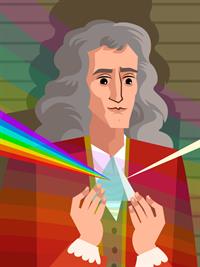PDF chapter test TRY NOW
Even though our Sun is a white star, its light will consist of a mixture of different colours. For example, when the soap bubble is blown, it appears colourful.

Many colours are visible in the Compact Disk (CD) when the light is reflected on them.

Rainbow
A natural phenomenon, the rainbow is a good example to show that light consists of many colours.
A rainbow is a large arc with many colours in the sky. It is visible on the opposite side of the Sun after a rainfall. A rainbow generally occurs when the Sun is positioned lower in the sky.

Formation of rainbow
After rainfall, a large number of tiny droplets will be present in the air. The white light from the Sun enters through these droplets and split them into seven colours. These seven colours escape out of the droplets and a make rainbow.
After rainfall, a large number of tiny droplets will be present in the air. The white light from the Sun enters through these droplets and split them into seven colours. These seven colours escape out of the droplets and a make rainbow.
Colours of rainbow
The seven colours of the rainbow are red, orange, yellow, green, blue, indigo and violet. These seven colours in a rainbow are not easy to distinguish. The order of these colours can be easily remembered by the acronym VIBGYOR.
The phenomenon of the rainbow is due to the dispersion of light. In 1665, Sir Isaac Newton, experimented with glass prisms and discovered the process of dispersion.

A glass prism is a transparent optical material with flat polished surfaces. A beam of white light, when passed through the prism, gets split into a band of colours. This band of seven colours are known as the spectrum of light.
